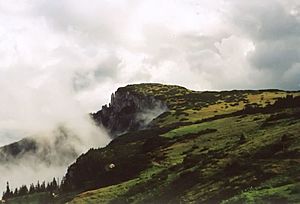Neamț County facts for kids
Quick facts for kids
Neamț County
Județul Neamț
|
||
|---|---|---|
|
||
 |
||
| Country | Romania | |
| Development region | Nord-Est | |
| Capital | Piatra Neamț | |
| Area | ||
| • Total | 5,897 km2 (2,277 sq mi) | |
| Area rank | 18th | |
| Population
(2021-12-01)
|
||
| • Total | 454,203 | |
| • Rank | 17th | |
| • Density | 77.023/km2 (199.488/sq mi) | |
| Telephone code | (+40) 233 or (+40) 333 | |
| ISO 3166 code | RO-NT | |
| GDP (nominal) | US$ 2.430 billion (2015) | |
| GDP per capita | US$ 5,161 (2015) | |
| Website | County Council Prefecture |
|
Neamț County is a special area in Romania. It is like a big district or region, called a județ in Romanian. You can find it in the historic area of Moldavia. The main city, or "county seat," is Piatra Neamț. The county gets its name from the Neamț River that flows through it.
Contents
People and Population
How Many People Live Here?
In 2011, about 470,766 people lived in Neamț County. This means there were about 80 people living in each square kilometer. Most people in the county are Romanians, making up about 98.25% of the population. Other groups include Roma and a few Lipovans and Hungarians.
| Year | County population |
|---|---|
| 1948 | 357,348 |
| 1956 | 419,949 |
| 1966 | 470,206 |
| 1977 | 532,096 |
| 1992 | 577,619 |
| 2002 | 554,516 |
| 2011 | 470,766 |
| 2021 | 454,203 |
What Religions Do People Follow?
Most people in Neamț County are Eastern Orthodox Christians. This is the main religion in Romania. There are also many Catholics and people of other faiths.
| Religion in Neamț County (2011) | ||||
|---|---|---|---|---|
| Eastern Orthodox | 83.2% | |||
| Catholic | 9.6% | |||
| Unknown | 5.0% | |||
| Other faiths (e.g. Seventh-day Adventists, Pentecostalism, Islam) |
2.2% | |||
Geography and Nature
Neamț County covers an area of about 5,897 square kilometers. The land changes a lot from west to east. In the west, you'll find tall mountains. These are part of the Eastern Carpathian Mountains. Some peaks are over 1,800 meters high, like the impressive Ceahlău Massif.
The Bicaz River flows through a deep valley. Here you can see the amazing Cheile Bicazului. In the 1950s, a large dam was built on the Bistrița River. This created Lake Izvorul Muntelui, also known as Lake Bicaz. It is the biggest artificial lake in Romania.
The lowest part of the county is in the east. It is along the Siret River's valley, about 160 meters above sea level.
Neighboring Counties
Neamț County shares its borders with several other counties:
- To the East: Iași County and Vaslui County
- To the West: Harghita County
- To the North: Suceava County
- To the South: Bacău County
Economy and Industry
Neamț County has several important industries. These include:
- Making chemicals
- Producing mechanical parts
- Creating textiles (like fabrics and clothes)
- Processing food
- Manufacturing construction materials
The Bicaz Dam is one of Romania's largest dams. It is built on the Bistrița River. The water from Bicaz Lake is used to make electricity at the Bicaz-Stejaru power station.
Fun Places to Visit
Neamț County is famous for having many monasteries. It is said to have the most monasteries per square kilometer in the world! The big church at Neamț Monastery was a model for many other churches in Moldavia. The art style here mixes old Gothic designs with Byzantine patterns.
The county is also home to two of Romania's nine national parks:
- The Ceahlău Massif
- The Vânători-Neamț Natural Park
Here are some of the main places to visit in Neamț County:
- The city of Piatra Neamț: It has a medieval square and places to ski.
- The city of Roman
- Famous Monasteries:
- Agapia Monastery
- Bistrița Monastery
- Durău Monastery
- Horaița Monastery
- Neamț Monastery
- Pângărați Monastery
- Petru Vodă Monastery
- Războieni Monastery
- Secu Monastery
- Sihăstria Monastery
- Sihla Monastery
- Văratec Monastery
- Vânători-Neamț Natural Park: A great place to see nature.
- Neamț Citadel: An old fortress in Târgu Neamț.
- Ceahlău National Park: Perfect for hiking and enjoying mountain views.
- Bicaz Canyon - "Cheile Bicazului": A stunning natural canyon.
- Durău Ski Resort: A popular spot for winter sports.
- Hanu Ancuței: A historic inn.
How the County is Organized
Neamț County has 2 big cities (called municipalities), 3 towns, and many smaller villages (communes).
Main Cities and Towns
- Municipalities:
- Piatra Neamț - This is the capital city. About 77,393 people lived here in 2011.
- Roman - About 45,344 people lived here in 2011.
- Towns:
- Bicaz
- Roznov
- Târgu Neamț
Famous People from Neamț County
Many talented people were born in Neamț County. Here are a few:
- Sergiu Celibidache: A famous conductor of orchestras.
- Vasile Conta: A well-known philosopher.
- Ion Creangă: A beloved Romanian writer.
- Virgil Gheorghiu: Another important writer.
- Ștefan Macovei: A modern sculptor.
- Nicodim Munteanu: A patriarch, who was a leader in the church.
Images for kids
-
Piatra Neamț from above.
See also
 In Spanish: Distrito de Neamț para niños
In Spanish: Distrito de Neamț para niños









